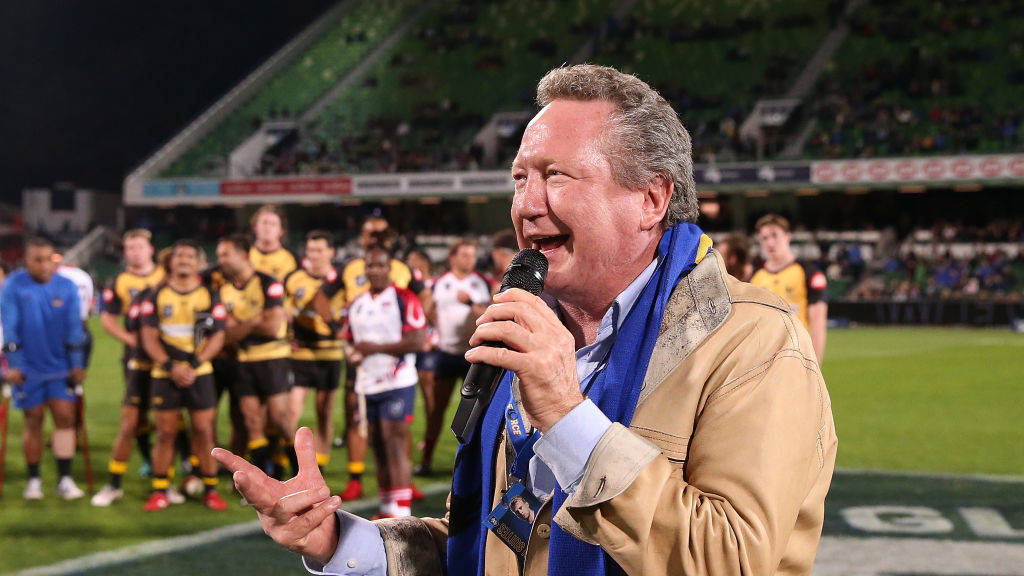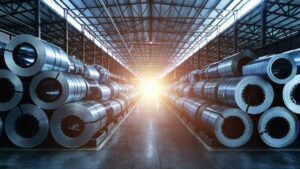Andrew Forrest pockets $4 billion windfall as FMG posts a record US$10.3bn profit

Picture: Paul Kane/Getty Images Sport via Getty Images.
Western Australian multi-billionaire Andrew Forrest is laughing all the way to the bank as record profits from his Fortescue Metals Group put nearly $4 billion worth of dividends in his pocket in the 2021 financial year.
FMG, which has taken a hit from weakening prices for iron ore in recent weeks, was the last of the majors to report their financial results this morning, posting a net profit after tax of US$10.3 billion.
That was 117% up FY20 on the back of a 96% rise in underlying EBITDA to US$16.4b, and an EBITDA margin of 73%.
The driving force was record annual shipments of 182.2Mt, and a 72% rise in average prices received from US$78.62 in 2020 to US$135.32 in 2021.
While FMG has always eaten a discount for the lower grade iron ore it ships relative to BHP and Rio Tinto, benchmark price levels were driven to historic records in the June Quarter by superheated demand from China.
FMG will pay a $2.11 a share dividend which, combined with a $1.47 interim dividend at its half year results will see the company pay out some $11 billion in dividends for 2021.
That represents a 103% increase on 2020’s distribution an 80% of NPAT, with Twiggy’s 36 per cent stake in FMG delivering him and his Minderoo Group a monster financial windfall.
The result was broadly in line with analyst expectations and justified calls from some analysts who viewed FMG as “oversold” after a slide in the iron ore price led to losses of more than 15% in the past month, with the company’s shares soaring by more than 5% in morning trade.
FMG buffs up climate credentials
FMG has buffed up its climate credentials as chairman and founder Andrew Forrest has made a major pivot in his image in recent months through the launch of its Fortescue Future Industries green hydrogen business.
It will pay 10% of NPAT into FFI to underpin its investments in decarbonisation technologies, green hydrogen and so-called ‘green steel’.
The company is aiming to reach “net zero” from its operations by 2030, 10 years earlier than previously planned and far ahead of where still undecided Government net zero targets are likely to end up, and will release a framework for “Scope 3” emissions produced by FMG customers by the end of September.
“The establishment of Fortescue Future Industries during the year underpinned our industry leading
target to achieve carbon neutrality by 2030. FFI will be a key enabler of this target through a
forward-looking approach to ensuring our capital investments in decarbonisation are aligned with
strategic decisions such as fleet renewal,” FMG chief executive Elizabeth Gaines said.
“As we execute on our strategy to become a global leader in the battle against climate change we
will establish goals to tackle emissions across our value chain, with specific targets, and a
framework for our approach to Scope 3 emissions, to be announced by 30 September 2021.”
FMG spent US$122 million through FFI in 2021 and has budgeted US$400-600 million of expenditure in FY2022, including US$100-200m of capex and US$300-400m in operating costs.
It will also spend around US$1.1-1.4b on major projects including the high-grade 22Mtpa Iron Bridge magnetite project, the next iron ore mine in the FMG pipeline after the completion of the Eliwana project in FY21.
Iron ore price kicks on ahead of construction season in China
The iron ore price has rebounded over the past week back in the vicinity of US$160/t.
Expectations of softening demand in China caused by government-mandated steel production cuts had seen it slide by over 40% in a matter of weeks from over US$200/t to around US$130/t just a fortnight ago.
According to Fastmarkets MB the benchmark 62% fines spot price was up US$4.63/t to US$157.55/t on Friday.
Iron ore traders and steel mills have shown stronger sentiment in recent weeks however as China’s peak construction season in September and October approaches.
“The increase was attributed to stronger demand in China’s construction sector. Construction activity in China typically increases in September and October,” Commbank analyst Vivek Dhar said in a note this morning.
“However, thin liquidity in the physical market may suggest that any meaningful pick-up in construction demand may not be sustained.
Output cuts have seen the price split between 65% Brazilian iron ore and the benchmark price contract, although mills are having to work hard to manage their costs in the wake of soaring prices for coking coal.
“For now, steel mills in China are looking to minimise coke usage to reduce costs,” Dhar said.
“Platts reports that some mills in China are finding that blending high-grade ore from Brazil with low-grade ore is helping achieve that. However, other mills still see steel costs being minimised by using medium grade ores (i.e. 62% Fe).”

UNLOCK INSIGHTS
Discover the untold stories of emerging ASX stocks.
Daily news and expert analysis, it's free to subscribe.
By proceeding, you confirm you understand that we handle personal information in accordance with our Privacy Policy.








